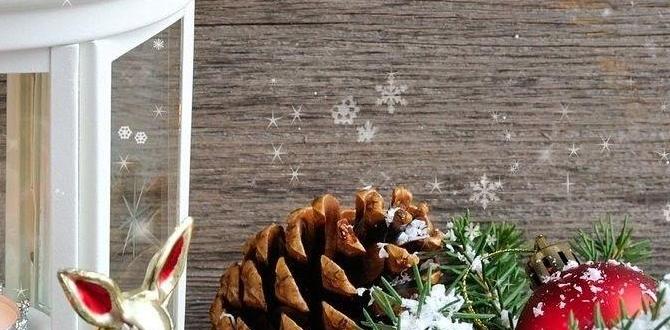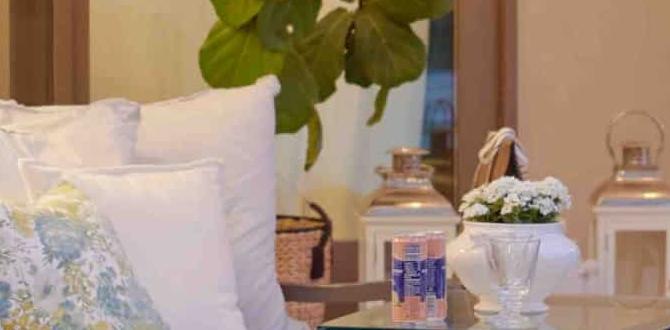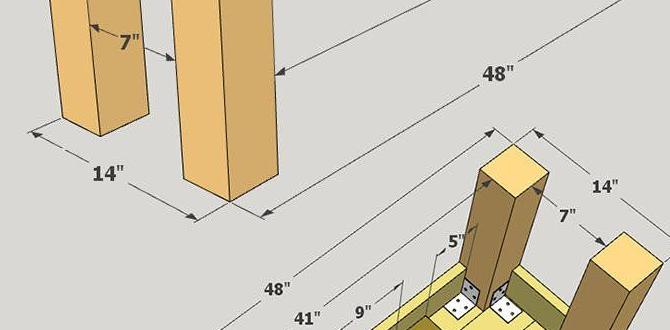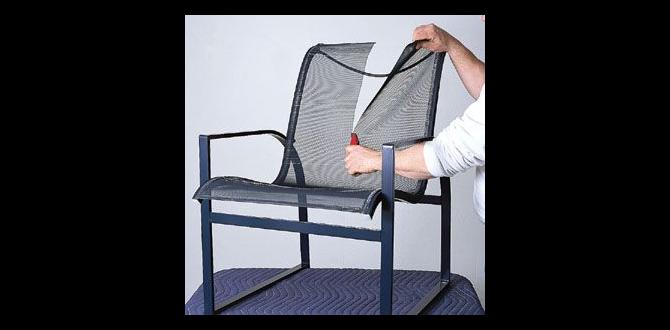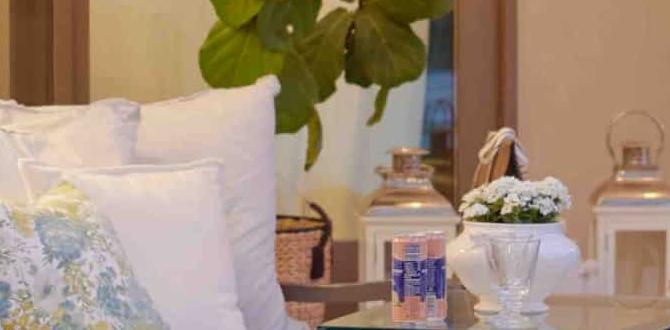Have you ever planned a picnic or a backyard barbecue? You want your outdoor furniture to look great and last long. But what material is best for outdoor furniture? Choosing the right material can make a big difference. Imagine relaxing on furniture that doesn’t fade or rot. Sounds nice, right?
Many people think wood is the best choice for outdoor furniture. But did you know some plastics are also great? They can resist water and snow. Plus, they’re light and easy to move. It’s amazing how many options you really have!
In this article, we’ll explore what material is best for outdoor furniture. Together, we’ll discover the pros and cons of different materials. By the end, you’ll know exactly what to choose for your perfect outdoor space!
What Material Is Best For Outdoor Furniture: Top Choices Explained When It Comes To Selecting Outdoor Furniture, The Material Plays A Crucial Role In Durability, Comfort, And Aesthetic Appeal. The Right Choice Can Withstand Various Weather Conditions While Still Maintaining Its Appearance And Structural Integrity Over Time. Below, We Explore Some Of The Best Materials Available For Outdoor Furniture, Examining Their Pros And Cons To Help You Make An Informed Decision. 1. Aluminum Aluminum Is A Popular Choice For Outdoor Furniture Due To Its Lightweight Nature And Resistance To Rust And Corrosion. This Material Is Easy To Move And Can Be Molded Into Various Designs, Making It Versatile For Different Styles. Additionally, Aluminum Is Low-Maintenance—Requiring Only Occasional Cleaning To Keep It Looking Its Best. However, Make Sure To Choose Powder-Coated Aluminum For Enhanced Durability. 2. Teak Wood Teak Is Often Hailed As The Gold Standard For Outdoor Furniture. Renowned For Its Natural Oils And High Density, Teak Is Resistant To Water, Insects, And Decay. This Wood Develops A Beautiful Silver Patina Over Time But Can Also Be Treated To Maintain Its Original Color. The Primary Drawback Is Its Cost, As Teak Is One Of The More Expensive Options Available. 3. Wicker (Synthetic) Synthetic Wicker, Often Made From High-Density Polyethylene (Hdpe), Offers A Weather-Resistant Option That Mimics The Look Of Traditional Wicker Without The Maintenance Issues. It’S Uv-Resistant And Won’T Fade In The Sun, Which Is Essential For Outdoor Settings. Synthetic Wicker Furniture Tends To Be More Affordable Compared To Natural Wicker But Still Provides A Stylish And Comfortable Option. 4. Stainless Steel Stainless Steel Is Another Excellent Material For Outdoor Furniture, Particularly Known For Its Strength And Modern Aesthetic. It Won’T Rust, Making It Suitable For Various Climates. However, It’S Essential To Maintain The Finish And Ensure That It Doesn’T Get Scratched, As This Can Lead To Corrosion Over Time. Pair Stainless Steel With Weather-Resistant Cushions For Added Comfort. 5. Resin Resin Furniture Is Both Lightweight And Highly Durable, Making It An Ideal Choice For Outdoor Spaces. It’S Impervious To Fading, Cracking, Or Peeling, Ensuring It Can Withstand Harsh Weather Conditions. Resin Furniture Often Comes In Various Colors And Styles, Making It Easy To Incorporate Into Different Outdoor Decor Themes. Conclusion In Summary, Selecting The Best Material For Outdoor Furniture Depends On Your Specific Needs, Budget, And Aesthetic Preferences. Materials Like Aluminum, Teak, Synthetic Wicker, Stainless Steel, And Resin Offer Distinct Advantages That Cater To Different Scenarios. Evaluating How Much Maintenance You’Re Willing To Undertake And The Climate In Which The Furniture Will Reside Will Help You Find The Perfect Fit To Enjoy Your Outdoor Space For Years To Come.
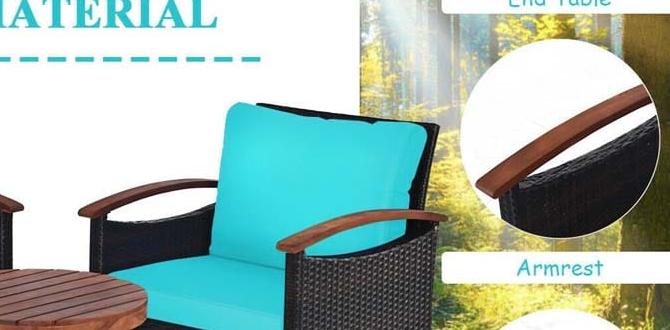
What Material is Best for Outdoor Furniture
Choosing the right material for outdoor furniture can make a big difference. Popular options include teak, wicker, and metal. Teak is durable and weather-resistant, while wicker offers a cozy look. Metal is strong but can get hot. Have you ever sat on a metal chair in the sun? Ouch! The right choice depends on your style and climate. Learn which material fits your needs for comfort and durability.Wooden Outdoor Furniture
Types of wood suitable for outdoor use (e.g., teak, eucalyptus). Pros and cons of wooden outdoor furniture.Wood makes great outdoor furniture. Some popular types are teak and eucalyptus. Teak is strong and lasts long. It’s also resistant to water, which is helpful in rain. Eucalyptus is a good choice too. It is good-looking and costs less. However, it needs more care. Here are some pros and cons:
- Pros:
- Stylish and classic look
- Can be very durable
- Comfortable to sit on
- Environmentally friendly if sourced wisely
- Cons:
- Can be expensive if not chosen wisely
- Requires regular maintenance to stay pretty
What is the best wood for outdoor furniture?
The best wood for outdoor furniture is teak due to its durability and weather resistance.
Why is teak popular for outdoor furniture?
Teak is popular because it can fight against rain, sun, and insects. It stays lovely for years without much effort.
Metal Outdoor Furniture
Common metals used (e.g., aluminum, wrought iron). Benefits and drawbacks of metal furniture.Metal furniture is strong and stylish. Common metals for outdoor use include aluminum and wrought iron. Aluminum is light and rust-resistant. Wrought iron is heavy and sturdy but can rust if not treated. Here are some benefits and drawbacks:
- Benefits:
- Durable and long-lasting.
- Easy to clean.
- Varies in design.
- Drawbacks:
- Can get hot in the sun.
- Wrought iron may need maintenance.
- Heavy and hard to move.
What is the best metal for outdoor furniture?
The best metal for outdoor furniture depends on your needs. Aluminum is often recommended for its lightweight and rust resistance. Wrought iron is great for strength but needs care to avoid rust.
Plastic and Resin Outdoor Furniture
Description of different types of plastics (e.g., polyethylene, PVC). Advantages of lightweight and weatherresistant properties.Outdoor furniture made from plastic, especially polyethylene and PVC, is popular for many reasons. Polyethylene is strong and can handle rough weather like a champ. PVC is great too, as it is light and durable. This type of furniture is easy to move around, making it perfect for impromptu dance parties in the yard! Plus, it doesn’t rust or fade, so your furniture can stay colorful throughout the years. Check out this quick comparison:
| Material | Weight | Weather Resistance |
|---|---|---|
| Polyethylene | Lightweight | Excellent |
| PVC | Very Lightweight | Good |
So there you have it! Plastic and resin furniture combines fun and function without weighing you down. Treat it well, and let the sunshine bring joy, not tears on those hot summer days!
Composite Materials
Explanation of composite outdoor furniture. Durability and maintenance comparison with traditional materials.Imagine having outdoor furniture that looks great and can handle crazy weather. That’s where composite materials come in! These clever mixes of wood fibers and plastic are super tough. They resist fading, cracking, and all those annoying stains. Forget about constant maintenance; with composite furniture, you can sip your lemonade without a care in the world. Unlike traditional wood or metal that needs love and care, composite materials let you enjoy your backyard without fuss!
| Material Type | Durability | Maintenance |
|---|---|---|
| Composite | High | Low |
| Wood | Medium | High |
| Metal | Medium | Medium |
Factors to Consider When Choosing Material
Climate considerations and how it affects material performance. Maintenance and care requirements for various materials.Weather affects how materials perform outdoors. Rain, sun, or snow can wear down furniture. For example, metal can rust, while wood may rot. Think about your local climate before choosing a material.
Also, some materials need more care than others. Here’s a quick list:
- Wood: Needs sealing often.
- Metal: Wipe clean and check for rust.
- Plastic: Just rinse off dirt.
Knowing this helps you pick the right material for your outdoor space!
What should I look for in outdoor furniture?
Consider climate, maintenance, and comfort. Your choices should match your weather and how much care you want to give.
Design and Style Compatibility
How material impacts the aesthetic appeal and design versatility. Tips for matching outdoor furniture with landscape and architecture.Choosing the right material for outdoor furniture can make a big difference in style and design. Some materials enhance the look of your space and can mix with different types of architecture. For instance, **wood adds warmth** while **metal offers a modern touch**. To match your furniture with your landscape, consider colors and textures. Look at your plants and home style; bright furniture pops against green gardens! Don’t forget to have fun with it – after all, it’s outdoor décor, not a funeral!
| Material | Aesthetic Appeal | Design Versatility |
|---|---|---|
| Wood | Warm and Natural | Traditional to Rustic |
| Metal | Chic and Modern | Contemporary to Industrial |
| Plastic | Bright and Fun | Casual to Playful |
Price Range and Value for Money
Comparison of costs across different materials. Evaluating longterm value versus initial investment.When choosing outdoor furniture, prices can differ greatly based on the material. Wooden furniture tends to be affordable but may not last as long. For example:
- Wood: Low cost, but requires maintenance.
- Metal: Mid-range price, often strong and weather-resistant.
- Plastic: Budget-friendly, lightweight but may fade over time.
- Teak: Higher price, but lasts for years and looks beautiful.
Think about how long you want your furniture to last. Sometimes spending more initially, like on teak, can mean better value later.
What is the best material for outdoor furniture?
Wood and metal are popular choices for outdoor furniture. They balance cost and durability well.
Conclusion
In conclusion, the best materials for outdoor furniture are aluminum, teak wood, and synthetic wicker. These options resist weather damage and require little maintenance. Choosing the right material keeps your furniture looking great and lasting longer. Now that you know, explore local stores or websites to find the perfect outdoor pieces for your space. Happy shopping!FAQs
What Are The Advantages And Disadvantages Of Using Metal Versus Wood For Outdoor Furniture?Metal furniture is strong and lasts a long time. It’s also easier to clean. But, metal can get really hot in the sun and might rust if it rains. Wood looks nice and feels warm, but it needs more care. If it rains a lot, wood can break down faster.
How Does The Climate Affect The Choice Of Materials For Outdoor Furniture?The climate really matters when we pick materials for outdoor furniture. If you live in a hot place, you might choose metal or plastic because they won’t rot. In rainy areas, wood needs special treatment to stay strong. In cold places, your furniture should be sturdy so it can handle snow and ice. Always think about the weather where you live!
Are There Specific Materials That Require Less Maintenance For Outdoor Furniture?Yes, some materials need less care for outdoor furniture. For example, plastic and metal are great choices. They resist weather well and don’t rust. Wood can look nice but needs more care. So, if you want easy-to-clean furniture, choose plastic or metal!
What Are The Environmental Impacts Of Different Materials Commonly Used For Outdoor Furniture?Different materials for outdoor furniture can affect the environment in various ways. Wood comes from trees, so cutting down too many can harm forests and wildlife. Plastic furniture, while durable, often comes from oil, which is not good for the planet. Metal like aluminum can be recycled, but mining it can hurt the earth. We should choose materials that are recycled or come from sustainable sources to help keep nature safe.
How Do Synthetic Materials, Like Polypropylene Or Resin, Compare To Natural Materials For Outdoor Furniture In Terms Of Durability And Aesthetics?Synthetic materials like polypropylene and resin are very strong. They can last for a long time, even in bad weather. Natural materials, like wood, can look beautiful, but they need more care. You might have to paint or seal wood to keep it nice. So, synthetic options are often easier to take care of and can still look good!
{“@context”:”https://schema.org”,”@type”: “FAQPage”,”mainEntity”:[{“@type”: “Question”,”name”: “What Are The Advantages And Disadvantages Of Using Metal Versus Wood For Outdoor Furniture? “,”acceptedAnswer”: {“@type”: “Answer”,”text”: “Metal furniture is strong and lasts a long time. It’s also easier to clean. But, metal can get really hot in the sun and might rust if it rains. Wood looks nice and feels warm, but it needs more care. If it rains a lot, wood can break down faster.”}},{“@type”: “Question”,”name”: “How Does The Climate Affect The Choice Of Materials For Outdoor Furniture? “,”acceptedAnswer”: {“@type”: “Answer”,”text”: “The climate really matters when we pick materials for outdoor furniture. If you live in a hot place, you might choose metal or plastic because they won’t rot. In rainy areas, wood needs special treatment to stay strong. In cold places, your furniture should be sturdy so it can handle snow and ice. Always think about the weather where you live!”}},{“@type”: “Question”,”name”: “Are There Specific Materials That Require Less Maintenance For Outdoor Furniture? “,”acceptedAnswer”: {“@type”: “Answer”,”text”: “Yes, some materials need less care for outdoor furniture. For example, plastic and metal are great choices. They resist weather well and don’t rust. Wood can look nice but needs more care. So, if you want easy-to-clean furniture, choose plastic or metal!”}},{“@type”: “Question”,”name”: “What Are The Environmental Impacts Of Different Materials Commonly Used For Outdoor Furniture? “,”acceptedAnswer”: {“@type”: “Answer”,”text”: “Different materials for outdoor furniture can affect the environment in various ways. Wood comes from trees, so cutting down too many can harm forests and wildlife. Plastic furniture, while durable, often comes from oil, which is not good for the planet. Metal like aluminum can be recycled, but mining it can hurt the earth. We should choose materials that are recycled or come from sustainable sources to help keep nature safe.”}},{“@type”: “Question”,”name”: “How Do Synthetic Materials, Like Polypropylene Or Resin, Compare To Natural Materials For Outdoor Furniture In Terms Of Durability And Aesthetics? “,”acceptedAnswer”: {“@type”: “Answer”,”text”: “Synthetic materials like polypropylene and resin are very strong. They can last for a long time, even in bad weather. Natural materials, like wood, can look beautiful, but they need more care. You might have to paint or seal wood to keep it nice. So, synthetic options are often easier to take care of and can still look good!”}}]}
